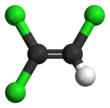
Back ثلاثي كلورو الإيثيلين Arabic Trixloretilen Azerbaijani تریکولورواتیلن AZB Трыхлорэтылен Byelorussian Tricloroetilè Catalan Trichlorethylen Czech Trichlorethen German 1,1,2-Trikloroetileno Esperanto Tricloroetileno Spanish Trikloroetileno Basque
This article needs additional citations for verification. (January 2021) |

| |||
| |||
 sample of Trichloroethylene
| |||
| Names | |||
|---|---|---|---|
| Preferred IUPAC name
Trichloroethene | |||
| Other names
1-Chloro-2,2-dichloroethylene; 1,1-Dichloro-2-chloroethylene; Acetylene Trichloride; Anamenth; HCO-1120; TCE; Trethylene; Triclene; Tri; Trico; Trilene; Trimar;
Terchlorethylene; Chloréthérise (archaic) | |||
| Identifiers | |||
3D model (JSmol)
|
|||
| Abbreviations | TCE | ||
| ChEBI | |||
| ChEMBL | |||
| ChemSpider | |||
| ECHA InfoCard | 100.001.062 | ||
| EC Number |
| ||
| KEGG | |||
PubChem CID
|
|||
| RTECS number |
| ||
| UNII | |||
| UN number | 1710 | ||
CompTox Dashboard (EPA)
|
|||
| |||
| |||
| Properties | |||
| C2HCl3 | |||
| Molar mass | 131.38 g·mol−1 | ||
| Appearance | Colorless liquid | ||
| Odor | pleasant, chloroform-like | ||
| Density | 1.46 g/cm3 at 20 °C | ||
| Melting point | −84.8 °C (−120.6 °F; 188.3 K)[5] | ||
| Boiling point | 86.7 °C (188.1 °F; 359.8 K)[1] | ||
| 1.280 g/L[1] | |||
| Solubility | Ether, ethanol, chloroform | ||
| log P | 2.26[2] | ||
| Vapor pressure | 58 mmHg (0.076 atm) at 20 °C[3] | ||
| −65.8·10−6 cm3/mol | |||
Refractive index (nD)
|
1.4777 at 19.8 °C | ||
| Viscosity | 0.532 mPa·s[4] | ||
| Pharmacology | |||
| N01AB05 (WHO) | |||
| Hazards | |||
| Occupational safety and health (OHS/OSH): | |||
Main hazards
|
Acute exposure can cause dizziness and loss of consciousness, chronic exposure can increase cancer risk. Unstable in presence of light. | ||
| GHS labelling: | |||
 
| |||
| NFPA 704 (fire diamond) | |||
| 420 °C (788 °F; 693 K) | |||
| Explosive limits | 8-10.5%[3] | ||
| Lethal dose or concentration (LD, LC): | |||
LD50 (median dose)
|
4920 mg/kg (oral, rat), 29000 mg/kg (dermal, rabbit)[6] | ||
LC50 (median concentration)
|
8450 ppm (mouse, 4 hr) 26300 (rat, 1 hr)[7] | ||
LCLo (lowest published)
|
2900 ppm (human) 37,200 ppm (guinea pig, 40 min) 5952 ppm (cat, 2 hr) 8000 ppm (rat, 4 hr) 11,000 (rabbit)[7] | ||
| NIOSH (US health exposure limits): | |||
PEL (Permissible)
|
TWA 100 ppm C 200 ppm 300 ppm (5-minute maximum peak in any 2 hours)[3] | ||
REL (Recommended)
|
Ca[3] | ||
IDLH (Immediate danger)
|
Ca [1000 ppm][3] | ||
| Safety data sheet (SDS) | Carl Roth | ||
| Legal status | |||
| Related compounds | |||
Related vinyl halides
|
Vinyl chloride Tetrachloroethylene Trifluoroethylene | ||
Related compounds
|
Chloroform 1,1,1-Trichloroethane 1,1,2-Trichloroethane | ||
| Supplementary data page | |||
| Trichloroethylene (data page) | |||
Except where otherwise noted, data are given for materials in their standard state (at 25 °C [77 °F], 100 kPa).
| |||
Trichloroethylene (TCE) is a halocarbon with the formula C2HCl3, commonly used as an industrial degreasing solvent. It is a clear, colourless, non-flammable, volatile liquid with a chloroform-like pleasant mild smell[3] and sweet taste.[9] Its IUPAC name is trichloroethene. Trichloroethylene has been sold under a variety of trade names. Industrial abbreviations include TCE, trichlor, Trike, Tricky and tri. Under the trade names Trimar and Trilene, it was used as a volatile anesthetic and as an inhaled obstetrical analgesic. It should not be confused with the similar 1,1,1-trichloroethane, which is commonly known as chlorothene.
TCE is classified as a volatile organic compound.[9]
- ^ a b "Trichloroethylene". Sigmaaldrich.com. Retrieved 20 October 2014.
- ^ "Trichloroethylene". www.chemsrc.com.
- ^ a b c d e f NIOSH Pocket Guide to Chemical Hazards. "#0629". National Institute for Occupational Safety and Health (NIOSH).
- ^ Venkatesulu, D.; Venkatesu, P.; Rao, M. V. Prabhakara (1997). "Viscosities and Densities of Trichloroethylene or Tetrachloroethylene with 2-Alkoxyethanols at 303.15 K and 313.15 K". Journal of Chemical & Engineering Data. 42 (2): 365–367. doi:10.1021/je960316f. ISSN 0021-9568.
- ^ "Safety Data Sheet". Retrieved 23 February 2022.
- ^ FischerSci Trichloroethylene SDS
- ^ a b "Trichloroethylene". Immediately Dangerous to Life or Health Concentrations (IDLH). National Institute for Occupational Safety and Health (NIOSH).
- ^ Anvisa (2023-03-31). "RDC Nº 784 - Listas de Substâncias Entorpecentes, Psicotrópicas, Precursoras e Outras sob Controle Especial" [Collegiate Board Resolution No. 784 - Lists of Narcotic, Psychotropic, Precursor, and Other Substances under Special Control] (in Brazilian Portuguese). Diário Oficial da União (published 2023-04-04). Archived from the original on 2023-08-03. Retrieved 2023-08-16.
- ^ a b Trichloroethylene (TCE) on ATSDR
© MMXXIII Rich X Search. We shall prevail. All rights reserved. Rich X Search


